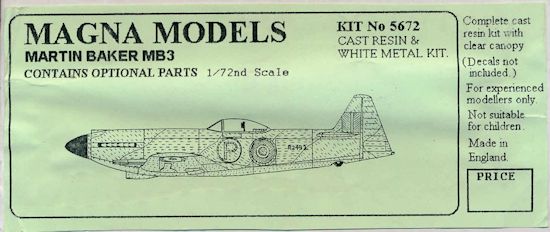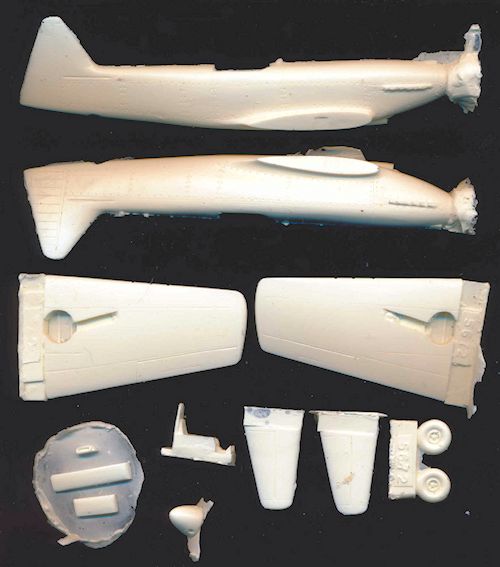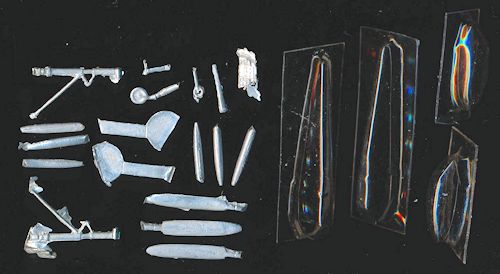
Magna Models 1/72 Martin-Baker MB.3
| KIT #: | 5672 |
| PRICE: | $25.00 |
| DECALS: | Only the P for prototype |
| REVIEWER: | Peter Burstow |
| NOTES: | Resin kit with metal parts and vac canopy |

| HISTORY |
Designed by Sir
James Martin, the third aircraft built by the Martin-Baker Aircraft Company, the
M.B.3, was a prototype fighter. First flown on August 31, 1942. It was fast at
415 mph, and one of the heaviest armed single engined aircraft at the time, with
six 20 mm cannon with 200 rounds per gun. It was powered by a 2000hp Napier
Sabre II, 24 cylinder sleeve valve engine. On September 12, 1942, the aircraft
crashed after engine failure, (a sleeve drive crank broke), killing the pilot,
company partner Captain Valentine Baker.
| THE KIT |

There are a few
bubbles on the usual thin areas like the fin and trailing edges of the wings.
There are a number of resin blobs on various surfaces. Judging by the amount of
mould material in some of the recesses, the mould was coming near the end of
it's useful life when my kit was made. There are scratches and gouges on the
parts, and pimples, lumps, dimples and divots as well. It will all need a bit of
filling and sanding, before I get to the joints.
All the resin parts have a liberal
coating of mould release wax, and will need a lot of washing to clean up. I have
found that rubbing alcohol or methylated spirits will help remove the wax.
Ethanol might work as well, but there are better uses for it!
 The cockpit
consists of a resin floor with integral seat and rudder pedals, and a white
metal control stick and instrument panel. There is no sidewall detail on the
fuselage halves, but the seat does have moulded belts.
The undercarriage wells have some moulded detail, as
well as a few resin blobs that will need removal. The wheels have moulded hub
detail, but no tread detail. A small piece of plasticard is supplied to make the
undercarriage inner doors, using a template on the instructions. The outer doors
and legs are white metal.
The cockpit
consists of a resin floor with integral seat and rudder pedals, and a white
metal control stick and instrument panel. There is no sidewall detail on the
fuselage halves, but the seat does have moulded belts.
The undercarriage wells have some moulded detail, as
well as a few resin blobs that will need removal. The wheels have moulded hub
detail, but no tread detail. A small piece of plasticard is supplied to make the
undercarriage inner doors, using a template on the instructions. The outer doors
and legs are white metal.
There are four
vacformed canopies supplied, two each of the bubble and razorback style. The
razorback canopies include the fuselage fairing. Nice to have a spare of each.
They are of thicker than usual plastic, not very clear and the framing lines are
not crisp. They also have been scored, roughly on a line about where they need
cut, probably a help as there is no obvious lip or other cutting guide.
The decals
provided are only the yellow 'P in a ring' prototype marks, all other markings
will need to come from the spares stash.
The instructions
are two A4 sheets, with a short history, a profile and decalling guide and some
construction notes. There is no detailed construction guide.
A dry fit shows
that the cockpit is too wide and high for the fuselage, a lot of carving will be
needed to get it to fit. The fuselage halves don't close up too well either. The
fuselage halves are not the same size, so there will be a step somewhere.
| CONCLUSIONS |
A short run mixed media kit of an
one-off British prototype fighter. Looks to be a straightforward build, with
more than the usual parts clean-up required. All the parts are well formed.
There are a number of surface problems to be fixed, which will destroy some of
the detail. Some experience would be needed as the instructions are not
comprehensive. The spare decals will need raided for markings.
Recommended for an experienced modeller. It might make a good wiffer!
| REFERENCES |
William Green,
Fighters Volume 2, Macdonald, London 1961
April 2013
If you would like your product reviewed fairly and fairly quickly, please contact the editor or see other details in the Note to Contributors.